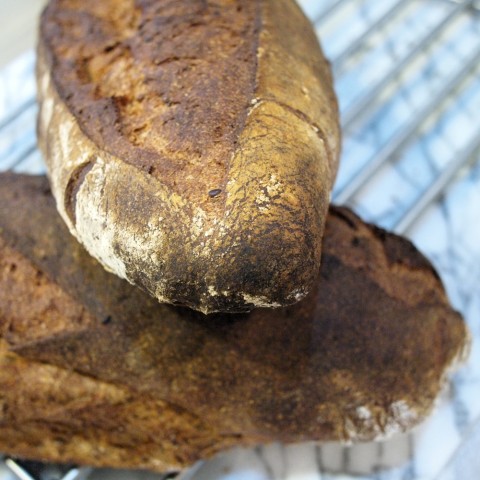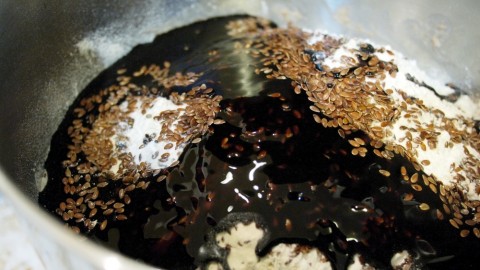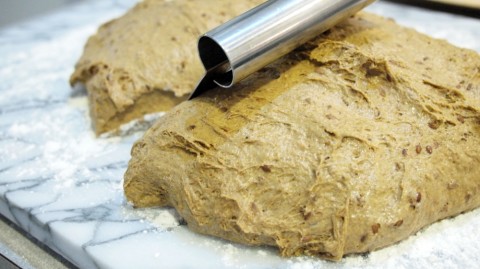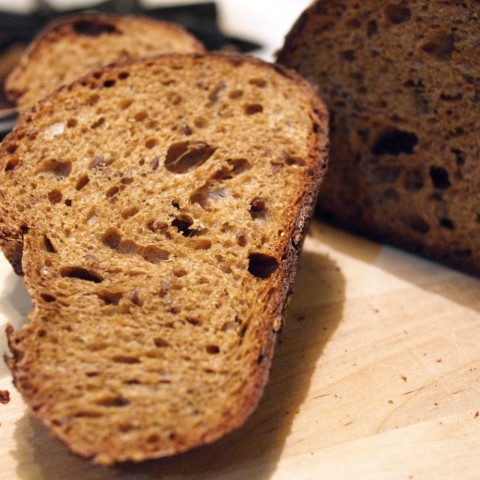Long story short, this bread is sort of a happy accident. For about a year, I’ve been working on a whole wheat brown bread — tweaking it, modifying its parts, trying to come up with a workable dough that would yield an open crumb, a thick crust, and a ton of flavor. Last week, I got it right. I made a loaf and thought to myself: ah ha! I need to share this recipe.
Then, a few days ago, I went to make it again so that I could take pictures for the blog. And what did I find? I was short some whole wheat flour. About a hundred grams to be exact.
I thought about making up the difference with more AP White. But I thought: the point of this loaf is that its mouth-feel should be rustic. And that would ruin the effect. So I threw in some rye flour instead, without too much in the way of high hopes, and baked.
I was committed to bringing some bread to a party, and the resulting loaves looked like they had potential. So I packed them up, untasted, and hit the road.
It turns out that they were a huge hit. Our hosts cubed some up to dip into fondue, and sliced some to go with Aji de Gallina (a super-fabulous chicken dish from Peru, masterminded by my friend Anna). And by the end of the night, the loaf was gone. And the compliments were very generous.
I have always been a little bit wary of rye flour. It yields a very sticky dough, and once or twice too often, it has resulted in a dough that just did not rise. But in this case, I think I’m changing my tune. Rye flour is my friend. Rye flour adds flavor, texture, and life to the loaf. Don’t fear the rye.
500 g Whole Wheat Flour
300 g Unbleached AP Flour
100 g Rye Flour
660 ml Water
125 ml Molasses
1/2 cup Flax Seeds
2 1/4 tsp Sea Salt
1/2 tsp Yeast
The Night Before: Combine 500ml of water, 250g of whole wheat flour, and the yeast in a bowl. Mix thoroughly, cover, and leave on the counter overnight.
The Day Of: Add the remainder of the ingredients, and mix on low with the kneading hook of your stand mixer (or with a wooden spoon) until it comes together into a dough. Turn the speed up to low medium — I like ‘4’ — and knead for 10-15 minutes (or 20-25 minutes, if doing it by hand) until the dough changes texture and becoming smooth and glossy. Be aware, though, that this is not like a white bread: the rye flour and the molasses mean that it will remain a little bit sticky, even when it is well kneaded.
Once the dough is kneaded, form into a ball, deposit in an oiled bowl, cover, and allow to rise for two hours and thirty minutes.
At the end of that time, set your oven up for bread baking (insert pizza stone, inverted jellyroll pan, or what have you) and preheat to 510F. Move the dough from its bowl onto a floured work surface. Use a knife (or bench knife) to cut the dough in half, and form each half into a loaf.* Place the loaves on a parchment-lined pizza peel, cover loosely with plastic wrap or with a moist tea towel, and allow to proof for one hour and ten minutes.
At the end of that time, slash the loaves** and insert into the oven. For the first three minutes of baking, spray the walls of the oven, at 30-second intervals, with water. After that, turn the oven down to 450F and allow to bake for thirty-five to forty minutes.
* I prefer to form these sorts of breads into batards. To do this, gently shape your unformed dough into a square. Then roll up, and pinch the ends. Be sure to maintain tension on the surface of the loaf — it helps produce better oven spring.
** You want to slash the loaves with a serrated knife like a steak or tomato knife. Your slashes should be a bit less than half an inch deep, and should be made at a 45-degree angle to the loaf.
(You can, of course, find many more fabulous bread recipes through Wild Yeast’s YeastSpotting Archive!)



